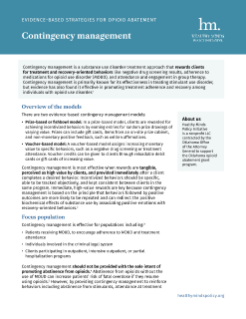| Adair | Harmon | Okmulgee |
| Beckham | Haskell | Osage |
| Caddo | Jefferson | Payne |
| Cherokee | Kingfisher | Pontotoc |
| Cleveland | Kiowa | Seminole |
| Comanche | LeFlore | Stephens |
| Creek | Lincoln | Tillman |
| Custer | Mayes | Tulsa |
| Grady | Muskogee | Wagoner |
| Greer | Oklahoma | Woodward |
Overview
Title 74, sections 30.3 through 30.8 create the Political Subdivisions Opioid Abatement Grants Act. The Act’s purpose is to promote and protect the health of Oklahomans by using monetary grants to abate the opioid crisis in a comprehensive manner that includes cooperation and collaboration with political subdivisions.
Grants will fund treatment and recovery programs, assistance with co-occurring disorders and mental health issues, opioid abuse education and prevention, proper prescription efforts, and strategies to decrease the supply of narcotics across the state. Grants are rigorously reviewed and approved by the Oklahoma Opioid Abatement Board comprising of the Attorney General and appointees of the Governor, Speaker of the House, Senate President Pro Tempore, State Treasurer, State Superintendent for Public Instruction, and State Auditor and Inspector.
Contact
Latest News & Newsletters
Monthly Newsletters
Grantee Newsletters
Potential Applicant Newsletters
2024 Grant Awards
The Oklahoma Opioid Abatement Board awarded $12 million in grant awards to 85 cities, counties, schools districts and public trusts to help address Oklahoma’s opioid crisis. Read the Opioid Abatement Board awards first round of grants news release.
| Bartlesville | Muskogee | Shawnee |
| Bixby | Norman | Stilwell |
| Edmond | Okmulgee | Tahlequah |
| Lawton | Ponca City | Warr Acres |
| Lone Grove | Pryor Creek |
| Bartlesville Public Schools | Lindsay Public Schools | Shawnee Public Schools |
| Bethany Public Schools | Marietta Public Schools | Stigler Public Schools |
| Comanche Public Schools | Maysville Public Schools | Stillwater Public Schools |
| Dickson Public Schools | Moore Public Schools | Stilwell Public Schools |
| Edmond Public Schools | Moseley Public Schools | Tishomingo Public Schools |
| Guthrie Public Schools | Norman Public Schools | Warner Public Schools |
| Guymon Public Schools | Owasso Public Schools | Western Heights Public Schools |
| Hilldale Public Schools | Pawhuska Public Schools | Westville Public Schools |
| Jenks Public Schools | Perkins-Tryon Public Schools | Metro Technology Centers |
| Keys School District | Purcell Public Schools | |
| Lawton Public Schools | Sand Springs Public Schools |
| Cardinal Point Public Trust | Norman Regional Hospital Authority |
| Comanche County Memorial Hospital Authority | Southwestern Oklahoma Development Authority |
| Grady Memorial Hospital Authority | Tahlequah Hospital Authority |
| McAlester Regional Health Center Authority |
| City of Altus & Jackson County |
| City of Claremore & Rogers County |
| City of Tulsa & Tulsa Public Schools |
Grant Application Resources
Priority Strategies for 2025 Opioid Abatement Grant Applications
Priority strategies for 2025 grant applications were identified through a review of best practices for opioid abatement informed by the National Association of Counties (NACo), Substance Abuse and Mental Health Services Administration’s Evidence-Based Practices Resource Center, and other registries of evidence-based practices and research-based opioid abatement guidance. The selected priorities conform with Exhibit E and Oklahoma’s approved purposes. The prioritized practices were informed by Oklahoma opioid abatement board member recommendations, which included focusing on strategies 1) in observed need of adoption/scaling in Oklahoma; 2) reasonably expected to be implemented effectively by grantees and produce outcomes during the project period; and 3) representing both preventive and treatment options.
Other Evidence-Based Strategies
Applicants may choose Other strategies with required justification as determined by the Opioid Abatement Board.
Grant Information
Reporting Concerns
Waste, fraud, and abuse drive up government costs and reduce services. To report concerns regarding misuse of opioid abatement grant funds, click the link below to submit a fraud report.










